Detailed Discharge Plan for Mr. Davies: Healthcare Analysis
VerifiedAdded on 2021/04/24
|19
|5203
|46
Report
AI Summary
This report provides a comprehensive discharge plan for Mr. Davies, focusing on his complex medical conditions including dementia, hypertension, and hyperlipidemia. The plan outlines patient information, family involvement, and the roles of community and social entities in supporting Mr. Davies's quality of life. It addresses evidence-based medicine, pharmacological interventions, psychosocial support, and lifestyle modifications. The report details the nature of Mr. Davies's conditions, their management, and potential complications. It emphasizes patient-centered care, medication compliance, and expected adverse reactions. The multidisciplinary team involved includes a general practitioner, district practice nurse, dietician, psychiatrist, neurologist, and other specialists. The plan aims to ensure a smooth transition from hospital to home care, minimizing readmissions and promoting the patient's health and recovery through addressing educational, medical, and non-medical needs.
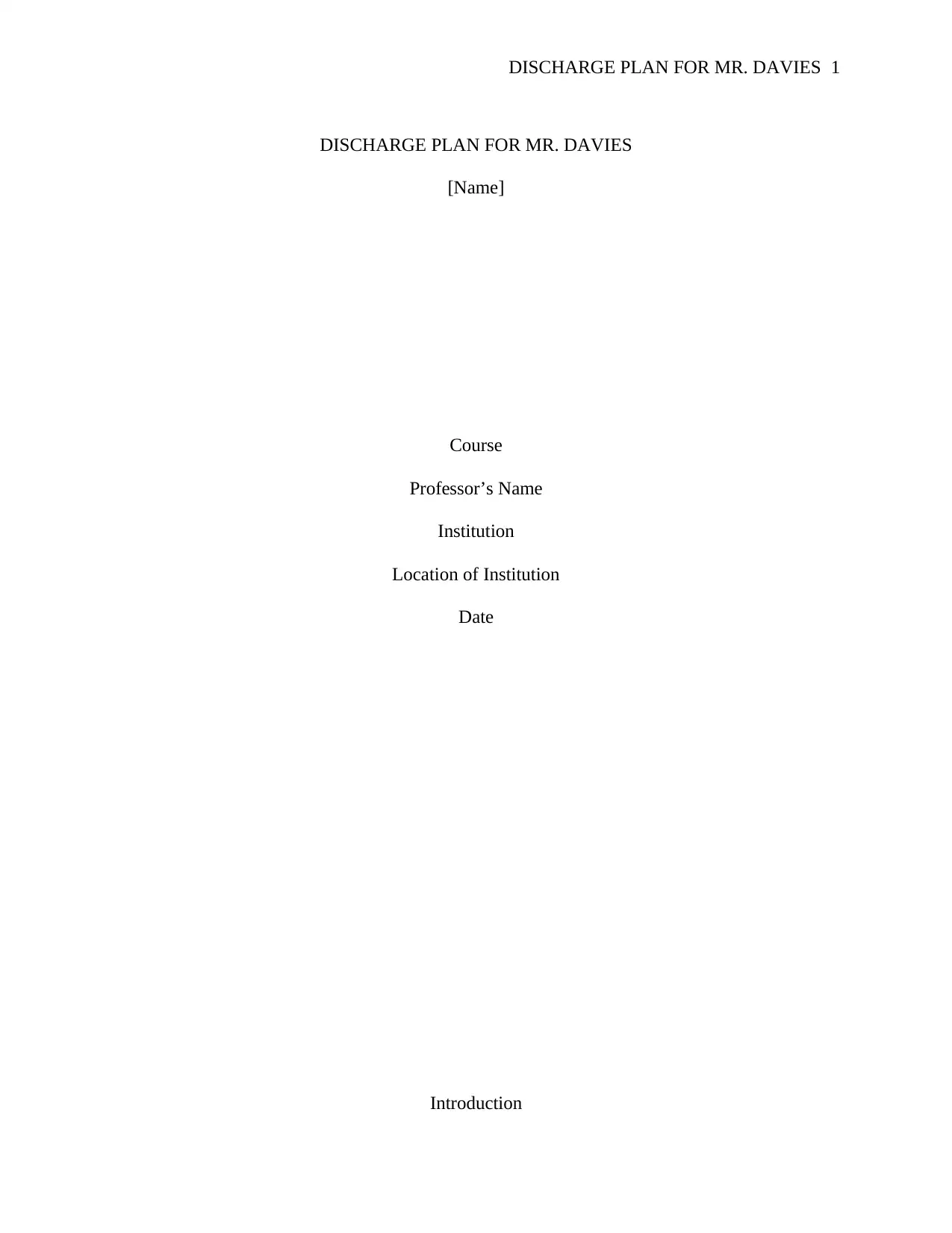
DISCHARGE PLAN FOR MR. DAVIES 1
DISCHARGE PLAN FOR MR. DAVIES
[Name]
Course
Professor’s Name
Institution
Location of Institution
Date
Introduction
DISCHARGE PLAN FOR MR. DAVIES
[Name]
Course
Professor’s Name
Institution
Location of Institution
Date
Introduction
Paraphrase This Document
Need a fresh take? Get an instant paraphrase of this document with our AI Paraphraser
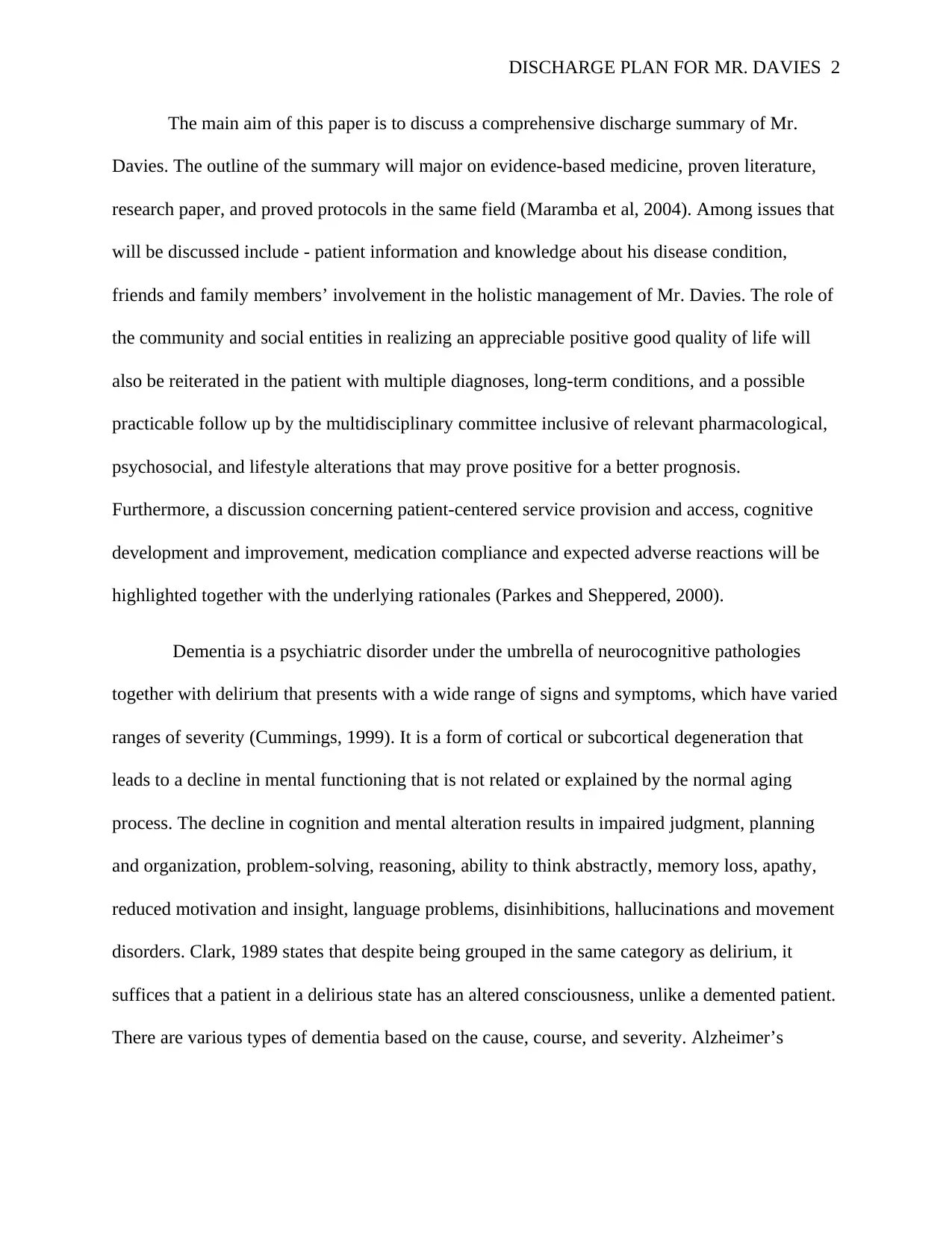
DISCHARGE PLAN FOR MR. DAVIES 2
The main aim of this paper is to discuss a comprehensive discharge summary of Mr.
Davies. The outline of the summary will major on evidence-based medicine, proven literature,
research paper, and proved protocols in the same field (Maramba et al, 2004). Among issues that
will be discussed include - patient information and knowledge about his disease condition,
friends and family members’ involvement in the holistic management of Mr. Davies. The role of
the community and social entities in realizing an appreciable positive good quality of life will
also be reiterated in the patient with multiple diagnoses, long-term conditions, and a possible
practicable follow up by the multidisciplinary committee inclusive of relevant pharmacological,
psychosocial, and lifestyle alterations that may prove positive for a better prognosis.
Furthermore, a discussion concerning patient-centered service provision and access, cognitive
development and improvement, medication compliance and expected adverse reactions will be
highlighted together with the underlying rationales (Parkes and Sheppered, 2000).
Dementia is a psychiatric disorder under the umbrella of neurocognitive pathologies
together with delirium that presents with a wide range of signs and symptoms, which have varied
ranges of severity (Cummings, 1999). It is a form of cortical or subcortical degeneration that
leads to a decline in mental functioning that is not related or explained by the normal aging
process. The decline in cognition and mental alteration results in impaired judgment, planning
and organization, problem-solving, reasoning, ability to think abstractly, memory loss, apathy,
reduced motivation and insight, language problems, disinhibitions, hallucinations and movement
disorders. Clark, 1989 states that despite being grouped in the same category as delirium, it
suffices that a patient in a delirious state has an altered consciousness, unlike a demented patient.
There are various types of dementia based on the cause, course, and severity. Alzheimer’s
The main aim of this paper is to discuss a comprehensive discharge summary of Mr.
Davies. The outline of the summary will major on evidence-based medicine, proven literature,
research paper, and proved protocols in the same field (Maramba et al, 2004). Among issues that
will be discussed include - patient information and knowledge about his disease condition,
friends and family members’ involvement in the holistic management of Mr. Davies. The role of
the community and social entities in realizing an appreciable positive good quality of life will
also be reiterated in the patient with multiple diagnoses, long-term conditions, and a possible
practicable follow up by the multidisciplinary committee inclusive of relevant pharmacological,
psychosocial, and lifestyle alterations that may prove positive for a better prognosis.
Furthermore, a discussion concerning patient-centered service provision and access, cognitive
development and improvement, medication compliance and expected adverse reactions will be
highlighted together with the underlying rationales (Parkes and Sheppered, 2000).
Dementia is a psychiatric disorder under the umbrella of neurocognitive pathologies
together with delirium that presents with a wide range of signs and symptoms, which have varied
ranges of severity (Cummings, 1999). It is a form of cortical or subcortical degeneration that
leads to a decline in mental functioning that is not related or explained by the normal aging
process. The decline in cognition and mental alteration results in impaired judgment, planning
and organization, problem-solving, reasoning, ability to think abstractly, memory loss, apathy,
reduced motivation and insight, language problems, disinhibitions, hallucinations and movement
disorders. Clark, 1989 states that despite being grouped in the same category as delirium, it
suffices that a patient in a delirious state has an altered consciousness, unlike a demented patient.
There are various types of dementia based on the cause, course, and severity. Alzheimer’s
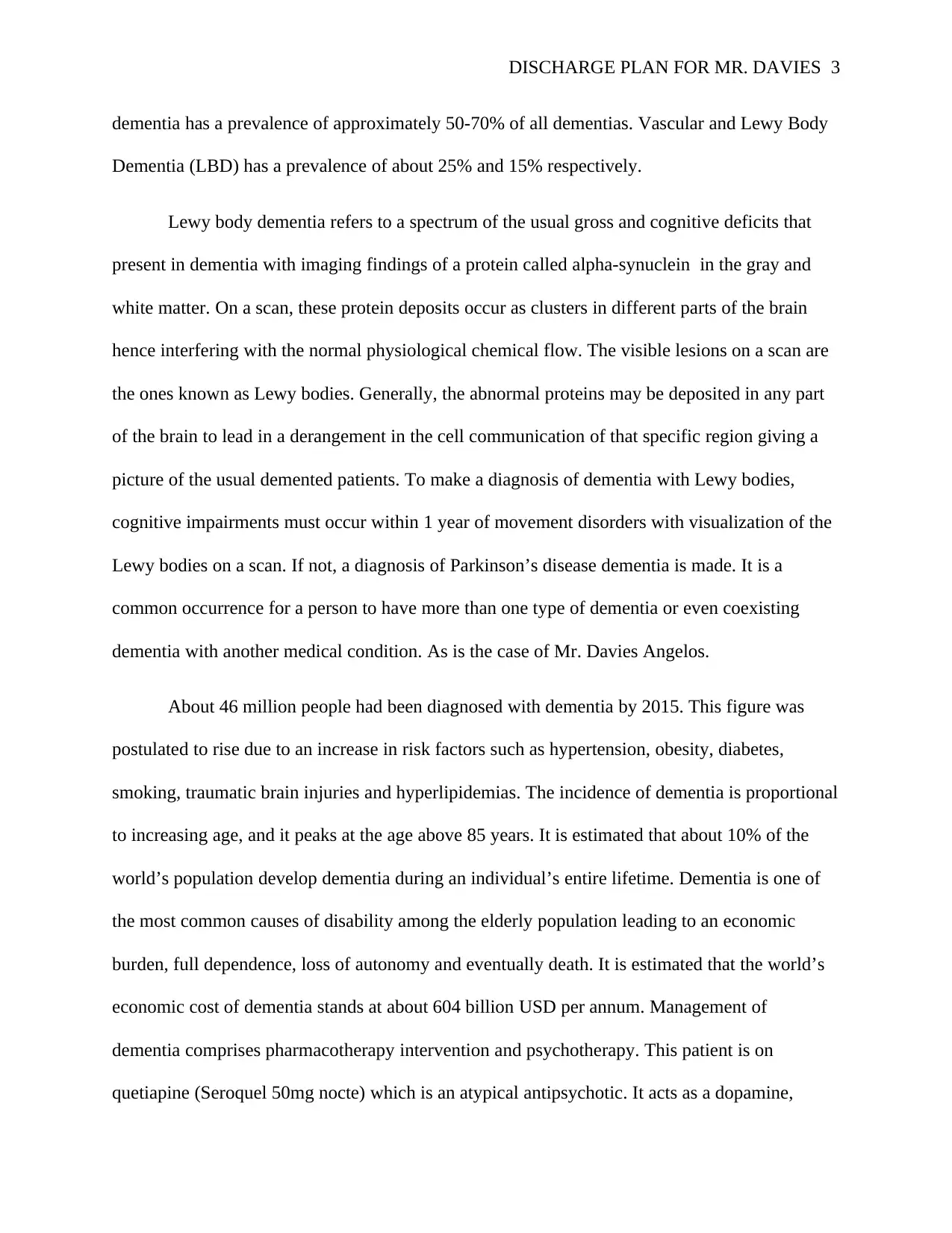
DISCHARGE PLAN FOR MR. DAVIES 3
dementia has a prevalence of approximately 50-70% of all dementias. Vascular and Lewy Body
Dementia (LBD) has a prevalence of about 25% and 15% respectively.
Lewy body dementia refers to a spectrum of the usual gross and cognitive deficits that
present in dementia with imaging findings of a protein called alpha-synuclein in the gray and
white matter. On a scan, these protein deposits occur as clusters in different parts of the brain
hence interfering with the normal physiological chemical flow. The visible lesions on a scan are
the ones known as Lewy bodies. Generally, the abnormal proteins may be deposited in any part
of the brain to lead in a derangement in the cell communication of that specific region giving a
picture of the usual demented patients. To make a diagnosis of dementia with Lewy bodies,
cognitive impairments must occur within 1 year of movement disorders with visualization of the
Lewy bodies on a scan. If not, a diagnosis of Parkinson’s disease dementia is made. It is a
common occurrence for a person to have more than one type of dementia or even coexisting
dementia with another medical condition. As is the case of Mr. Davies Angelos.
About 46 million people had been diagnosed with dementia by 2015. This figure was
postulated to rise due to an increase in risk factors such as hypertension, obesity, diabetes,
smoking, traumatic brain injuries and hyperlipidemias. The incidence of dementia is proportional
to increasing age, and it peaks at the age above 85 years. It is estimated that about 10% of the
world’s population develop dementia during an individual’s entire lifetime. Dementia is one of
the most common causes of disability among the elderly population leading to an economic
burden, full dependence, loss of autonomy and eventually death. It is estimated that the world’s
economic cost of dementia stands at about 604 billion USD per annum. Management of
dementia comprises pharmacotherapy intervention and psychotherapy. This patient is on
quetiapine (Seroquel 50mg nocte) which is an atypical antipsychotic. It acts as a dopamine,
dementia has a prevalence of approximately 50-70% of all dementias. Vascular and Lewy Body
Dementia (LBD) has a prevalence of about 25% and 15% respectively.
Lewy body dementia refers to a spectrum of the usual gross and cognitive deficits that
present in dementia with imaging findings of a protein called alpha-synuclein in the gray and
white matter. On a scan, these protein deposits occur as clusters in different parts of the brain
hence interfering with the normal physiological chemical flow. The visible lesions on a scan are
the ones known as Lewy bodies. Generally, the abnormal proteins may be deposited in any part
of the brain to lead in a derangement in the cell communication of that specific region giving a
picture of the usual demented patients. To make a diagnosis of dementia with Lewy bodies,
cognitive impairments must occur within 1 year of movement disorders with visualization of the
Lewy bodies on a scan. If not, a diagnosis of Parkinson’s disease dementia is made. It is a
common occurrence for a person to have more than one type of dementia or even coexisting
dementia with another medical condition. As is the case of Mr. Davies Angelos.
About 46 million people had been diagnosed with dementia by 2015. This figure was
postulated to rise due to an increase in risk factors such as hypertension, obesity, diabetes,
smoking, traumatic brain injuries and hyperlipidemias. The incidence of dementia is proportional
to increasing age, and it peaks at the age above 85 years. It is estimated that about 10% of the
world’s population develop dementia during an individual’s entire lifetime. Dementia is one of
the most common causes of disability among the elderly population leading to an economic
burden, full dependence, loss of autonomy and eventually death. It is estimated that the world’s
economic cost of dementia stands at about 604 billion USD per annum. Management of
dementia comprises pharmacotherapy intervention and psychotherapy. This patient is on
quetiapine (Seroquel 50mg nocte) which is an atypical antipsychotic. It acts as a dopamine,
⊘ This is a preview!⊘
Do you want full access?
Subscribe today to unlock all pages.

Trusted by 1+ million students worldwide
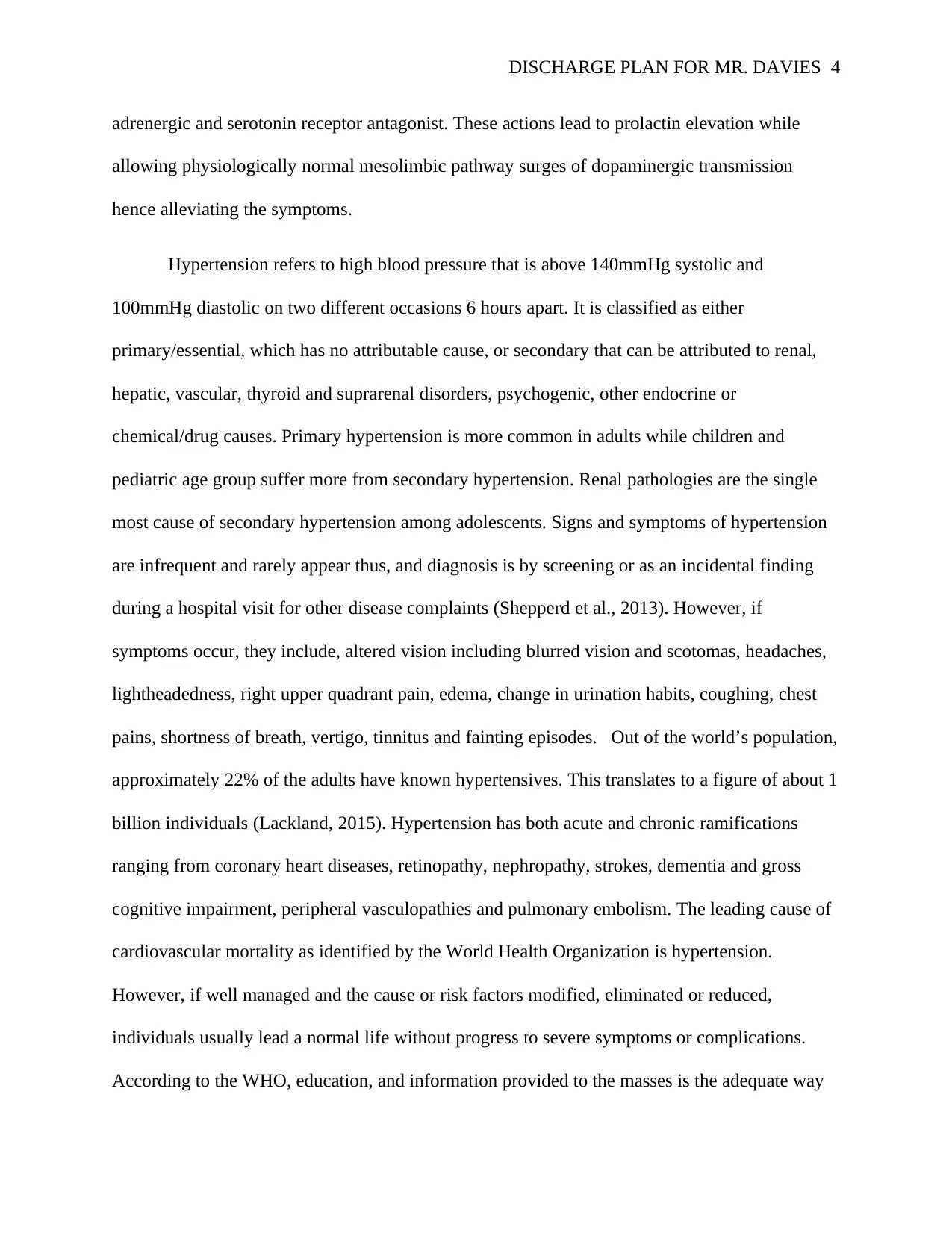
DISCHARGE PLAN FOR MR. DAVIES 4
adrenergic and serotonin receptor antagonist. These actions lead to prolactin elevation while
allowing physiologically normal mesolimbic pathway surges of dopaminergic transmission
hence alleviating the symptoms.
Hypertension refers to high blood pressure that is above 140mmHg systolic and
100mmHg diastolic on two different occasions 6 hours apart. It is classified as either
primary/essential, which has no attributable cause, or secondary that can be attributed to renal,
hepatic, vascular, thyroid and suprarenal disorders, psychogenic, other endocrine or
chemical/drug causes. Primary hypertension is more common in adults while children and
pediatric age group suffer more from secondary hypertension. Renal pathologies are the single
most cause of secondary hypertension among adolescents. Signs and symptoms of hypertension
are infrequent and rarely appear thus, and diagnosis is by screening or as an incidental finding
during a hospital visit for other disease complaints (Shepperd et al., 2013). However, if
symptoms occur, they include, altered vision including blurred vision and scotomas, headaches,
lightheadedness, right upper quadrant pain, edema, change in urination habits, coughing, chest
pains, shortness of breath, vertigo, tinnitus and fainting episodes. Out of the world’s population,
approximately 22% of the adults have known hypertensives. This translates to a figure of about 1
billion individuals (Lackland, 2015). Hypertension has both acute and chronic ramifications
ranging from coronary heart diseases, retinopathy, nephropathy, strokes, dementia and gross
cognitive impairment, peripheral vasculopathies and pulmonary embolism. The leading cause of
cardiovascular mortality as identified by the World Health Organization is hypertension.
However, if well managed and the cause or risk factors modified, eliminated or reduced,
individuals usually lead a normal life without progress to severe symptoms or complications.
According to the WHO, education, and information provided to the masses is the adequate way
adrenergic and serotonin receptor antagonist. These actions lead to prolactin elevation while
allowing physiologically normal mesolimbic pathway surges of dopaminergic transmission
hence alleviating the symptoms.
Hypertension refers to high blood pressure that is above 140mmHg systolic and
100mmHg diastolic on two different occasions 6 hours apart. It is classified as either
primary/essential, which has no attributable cause, or secondary that can be attributed to renal,
hepatic, vascular, thyroid and suprarenal disorders, psychogenic, other endocrine or
chemical/drug causes. Primary hypertension is more common in adults while children and
pediatric age group suffer more from secondary hypertension. Renal pathologies are the single
most cause of secondary hypertension among adolescents. Signs and symptoms of hypertension
are infrequent and rarely appear thus, and diagnosis is by screening or as an incidental finding
during a hospital visit for other disease complaints (Shepperd et al., 2013). However, if
symptoms occur, they include, altered vision including blurred vision and scotomas, headaches,
lightheadedness, right upper quadrant pain, edema, change in urination habits, coughing, chest
pains, shortness of breath, vertigo, tinnitus and fainting episodes. Out of the world’s population,
approximately 22% of the adults have known hypertensives. This translates to a figure of about 1
billion individuals (Lackland, 2015). Hypertension has both acute and chronic ramifications
ranging from coronary heart diseases, retinopathy, nephropathy, strokes, dementia and gross
cognitive impairment, peripheral vasculopathies and pulmonary embolism. The leading cause of
cardiovascular mortality as identified by the World Health Organization is hypertension.
However, if well managed and the cause or risk factors modified, eliminated or reduced,
individuals usually lead a normal life without progress to severe symptoms or complications.
According to the WHO, education, and information provided to the masses is the adequate way
Paraphrase This Document
Need a fresh take? Get an instant paraphrase of this document with our AI Paraphraser
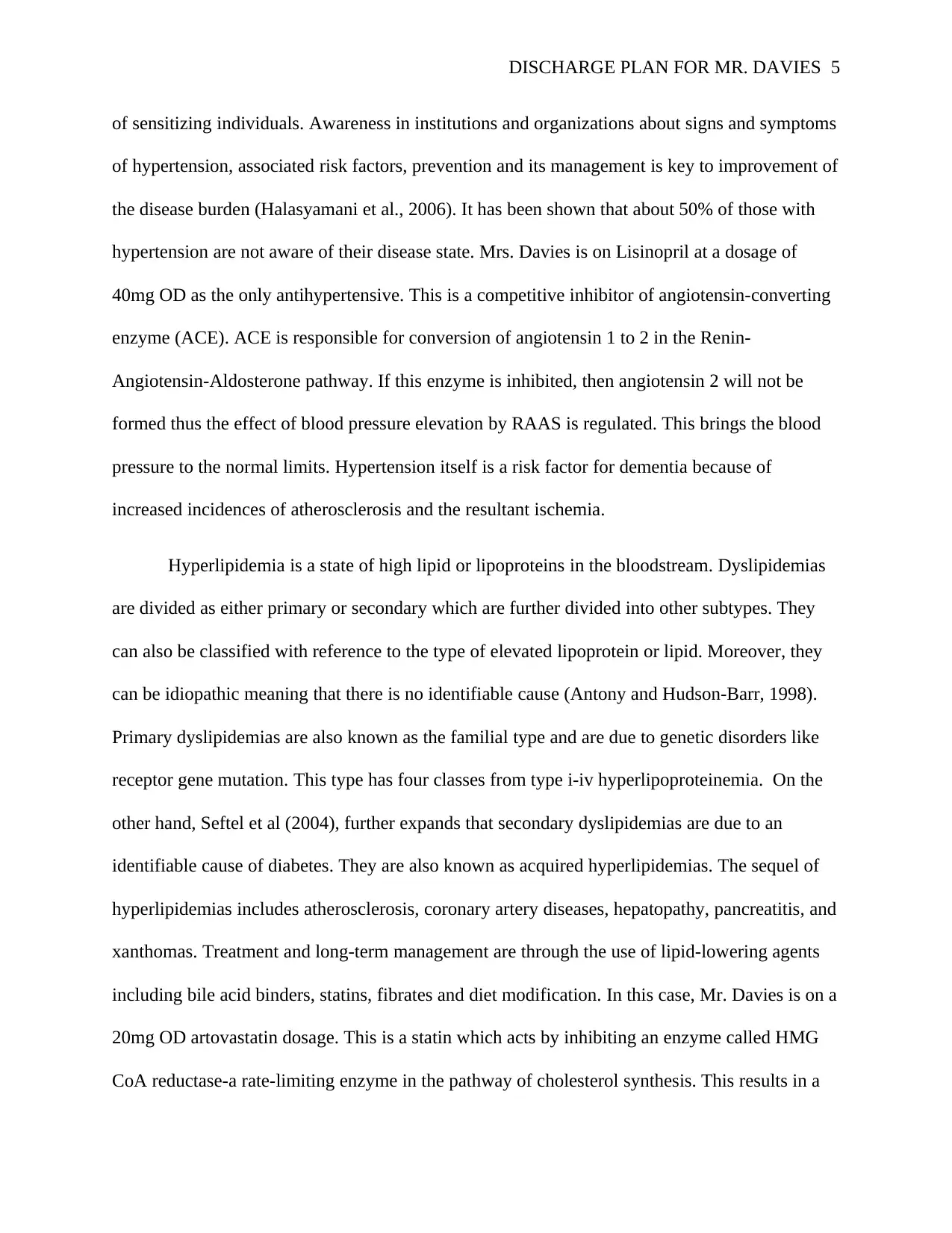
DISCHARGE PLAN FOR MR. DAVIES 5
of sensitizing individuals. Awareness in institutions and organizations about signs and symptoms
of hypertension, associated risk factors, prevention and its management is key to improvement of
the disease burden (Halasyamani et al., 2006). It has been shown that about 50% of those with
hypertension are not aware of their disease state. Mrs. Davies is on Lisinopril at a dosage of
40mg OD as the only antihypertensive. This is a competitive inhibitor of angiotensin-converting
enzyme (ACE). ACE is responsible for conversion of angiotensin 1 to 2 in the Renin-
Angiotensin-Aldosterone pathway. If this enzyme is inhibited, then angiotensin 2 will not be
formed thus the effect of blood pressure elevation by RAAS is regulated. This brings the blood
pressure to the normal limits. Hypertension itself is a risk factor for dementia because of
increased incidences of atherosclerosis and the resultant ischemia.
Hyperlipidemia is a state of high lipid or lipoproteins in the bloodstream. Dyslipidemias
are divided as either primary or secondary which are further divided into other subtypes. They
can also be classified with reference to the type of elevated lipoprotein or lipid. Moreover, they
can be idiopathic meaning that there is no identifiable cause (Antony and Hudson-Barr, 1998).
Primary dyslipidemias are also known as the familial type and are due to genetic disorders like
receptor gene mutation. This type has four classes from type i-iv hyperlipoproteinemia. On the
other hand, Seftel et al (2004), further expands that secondary dyslipidemias are due to an
identifiable cause of diabetes. They are also known as acquired hyperlipidemias. The sequel of
hyperlipidemias includes atherosclerosis, coronary artery diseases, hepatopathy, pancreatitis, and
xanthomas. Treatment and long-term management are through the use of lipid-lowering agents
including bile acid binders, statins, fibrates and diet modification. In this case, Mr. Davies is on a
20mg OD artovastatin dosage. This is a statin which acts by inhibiting an enzyme called HMG
CoA reductase-a rate-limiting enzyme in the pathway of cholesterol synthesis. This results in a
of sensitizing individuals. Awareness in institutions and organizations about signs and symptoms
of hypertension, associated risk factors, prevention and its management is key to improvement of
the disease burden (Halasyamani et al., 2006). It has been shown that about 50% of those with
hypertension are not aware of their disease state. Mrs. Davies is on Lisinopril at a dosage of
40mg OD as the only antihypertensive. This is a competitive inhibitor of angiotensin-converting
enzyme (ACE). ACE is responsible for conversion of angiotensin 1 to 2 in the Renin-
Angiotensin-Aldosterone pathway. If this enzyme is inhibited, then angiotensin 2 will not be
formed thus the effect of blood pressure elevation by RAAS is regulated. This brings the blood
pressure to the normal limits. Hypertension itself is a risk factor for dementia because of
increased incidences of atherosclerosis and the resultant ischemia.
Hyperlipidemia is a state of high lipid or lipoproteins in the bloodstream. Dyslipidemias
are divided as either primary or secondary which are further divided into other subtypes. They
can also be classified with reference to the type of elevated lipoprotein or lipid. Moreover, they
can be idiopathic meaning that there is no identifiable cause (Antony and Hudson-Barr, 1998).
Primary dyslipidemias are also known as the familial type and are due to genetic disorders like
receptor gene mutation. This type has four classes from type i-iv hyperlipoproteinemia. On the
other hand, Seftel et al (2004), further expands that secondary dyslipidemias are due to an
identifiable cause of diabetes. They are also known as acquired hyperlipidemias. The sequel of
hyperlipidemias includes atherosclerosis, coronary artery diseases, hepatopathy, pancreatitis, and
xanthomas. Treatment and long-term management are through the use of lipid-lowering agents
including bile acid binders, statins, fibrates and diet modification. In this case, Mr. Davies is on a
20mg OD artovastatin dosage. This is a statin which acts by inhibiting an enzyme called HMG
CoA reductase-a rate-limiting enzyme in the pathway of cholesterol synthesis. This results in a
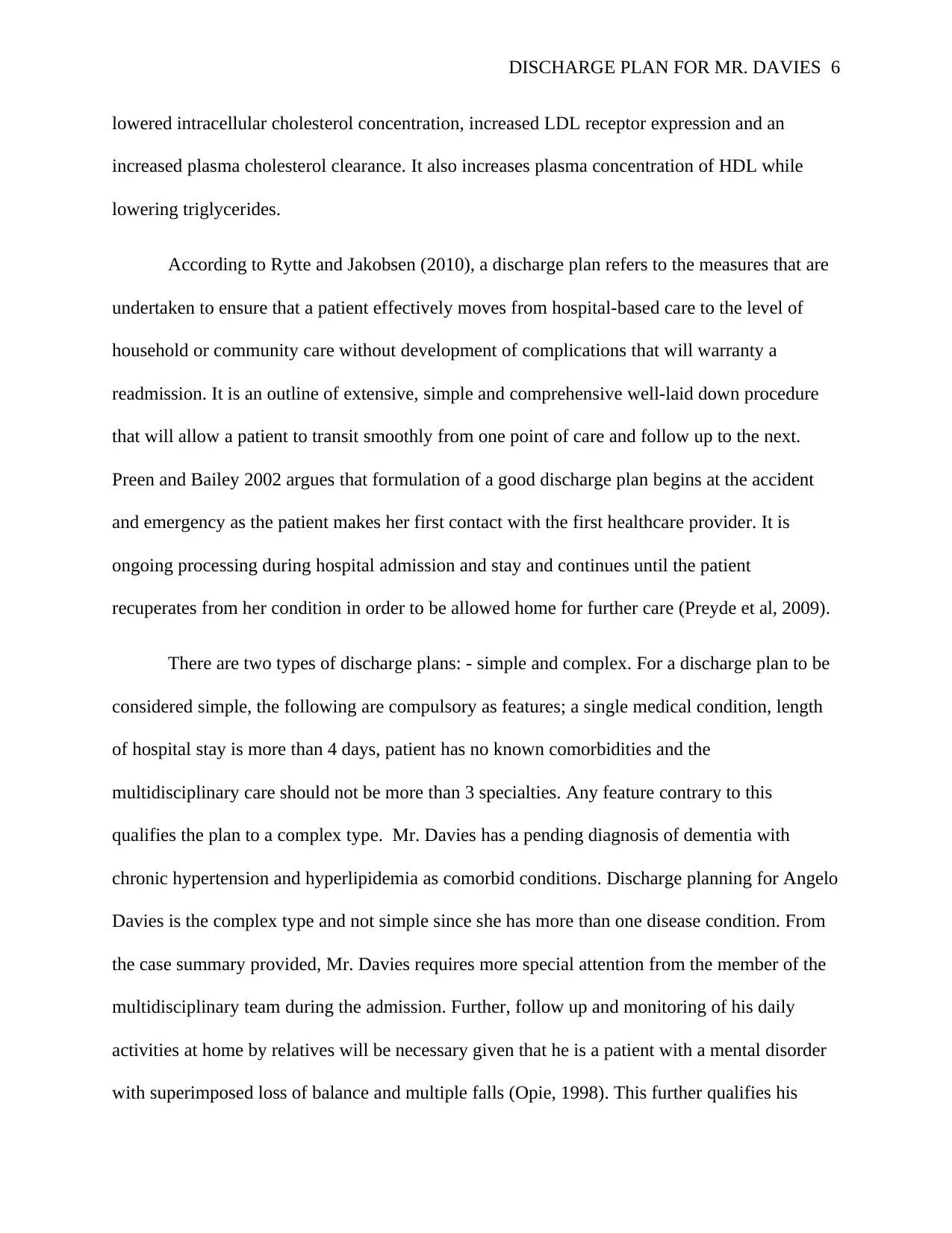
DISCHARGE PLAN FOR MR. DAVIES 6
lowered intracellular cholesterol concentration, increased LDL receptor expression and an
increased plasma cholesterol clearance. It also increases plasma concentration of HDL while
lowering triglycerides.
According to Rytte and Jakobsen (2010), a discharge plan refers to the measures that are
undertaken to ensure that a patient effectively moves from hospital-based care to the level of
household or community care without development of complications that will warranty a
readmission. It is an outline of extensive, simple and comprehensive well-laid down procedure
that will allow a patient to transit smoothly from one point of care and follow up to the next.
Preen and Bailey 2002 argues that formulation of a good discharge plan begins at the accident
and emergency as the patient makes her first contact with the first healthcare provider. It is
ongoing processing during hospital admission and stay and continues until the patient
recuperates from her condition in order to be allowed home for further care (Preyde et al, 2009).
There are two types of discharge plans: - simple and complex. For a discharge plan to be
considered simple, the following are compulsory as features; a single medical condition, length
of hospital stay is more than 4 days, patient has no known comorbidities and the
multidisciplinary care should not be more than 3 specialties. Any feature contrary to this
qualifies the plan to a complex type. Mr. Davies has a pending diagnosis of dementia with
chronic hypertension and hyperlipidemia as comorbid conditions. Discharge planning for Angelo
Davies is the complex type and not simple since she has more than one disease condition. From
the case summary provided, Mr. Davies requires more special attention from the member of the
multidisciplinary team during the admission. Further, follow up and monitoring of his daily
activities at home by relatives will be necessary given that he is a patient with a mental disorder
with superimposed loss of balance and multiple falls (Opie, 1998). This further qualifies his
lowered intracellular cholesterol concentration, increased LDL receptor expression and an
increased plasma cholesterol clearance. It also increases plasma concentration of HDL while
lowering triglycerides.
According to Rytte and Jakobsen (2010), a discharge plan refers to the measures that are
undertaken to ensure that a patient effectively moves from hospital-based care to the level of
household or community care without development of complications that will warranty a
readmission. It is an outline of extensive, simple and comprehensive well-laid down procedure
that will allow a patient to transit smoothly from one point of care and follow up to the next.
Preen and Bailey 2002 argues that formulation of a good discharge plan begins at the accident
and emergency as the patient makes her first contact with the first healthcare provider. It is
ongoing processing during hospital admission and stay and continues until the patient
recuperates from her condition in order to be allowed home for further care (Preyde et al, 2009).
There are two types of discharge plans: - simple and complex. For a discharge plan to be
considered simple, the following are compulsory as features; a single medical condition, length
of hospital stay is more than 4 days, patient has no known comorbidities and the
multidisciplinary care should not be more than 3 specialties. Any feature contrary to this
qualifies the plan to a complex type. Mr. Davies has a pending diagnosis of dementia with
chronic hypertension and hyperlipidemia as comorbid conditions. Discharge planning for Angelo
Davies is the complex type and not simple since she has more than one disease condition. From
the case summary provided, Mr. Davies requires more special attention from the member of the
multidisciplinary team during the admission. Further, follow up and monitoring of his daily
activities at home by relatives will be necessary given that he is a patient with a mental disorder
with superimposed loss of balance and multiple falls (Opie, 1998). This further qualifies his
⊘ This is a preview!⊘
Do you want full access?
Subscribe today to unlock all pages.

Trusted by 1+ million students worldwide
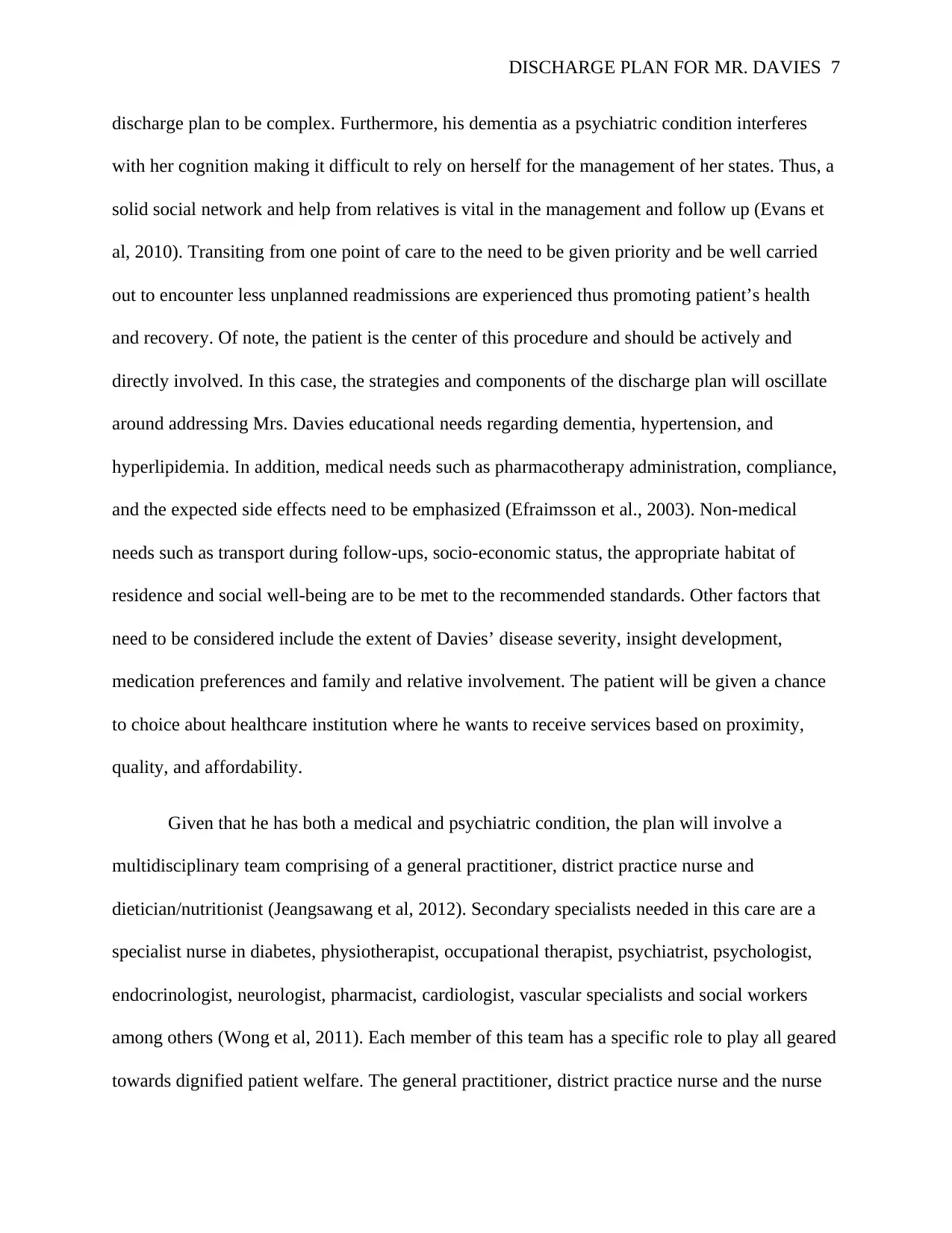
DISCHARGE PLAN FOR MR. DAVIES 7
discharge plan to be complex. Furthermore, his dementia as a psychiatric condition interferes
with her cognition making it difficult to rely on herself for the management of her states. Thus, a
solid social network and help from relatives is vital in the management and follow up (Evans et
al, 2010). Transiting from one point of care to the need to be given priority and be well carried
out to encounter less unplanned readmissions are experienced thus promoting patient’s health
and recovery. Of note, the patient is the center of this procedure and should be actively and
directly involved. In this case, the strategies and components of the discharge plan will oscillate
around addressing Mrs. Davies educational needs regarding dementia, hypertension, and
hyperlipidemia. In addition, medical needs such as pharmacotherapy administration, compliance,
and the expected side effects need to be emphasized (Efraimsson et al., 2003). Non-medical
needs such as transport during follow-ups, socio-economic status, the appropriate habitat of
residence and social well-being are to be met to the recommended standards. Other factors that
need to be considered include the extent of Davies’ disease severity, insight development,
medication preferences and family and relative involvement. The patient will be given a chance
to choice about healthcare institution where he wants to receive services based on proximity,
quality, and affordability.
Given that he has both a medical and psychiatric condition, the plan will involve a
multidisciplinary team comprising of a general practitioner, district practice nurse and
dietician/nutritionist (Jeangsawang et al, 2012). Secondary specialists needed in this care are a
specialist nurse in diabetes, physiotherapist, occupational therapist, psychiatrist, psychologist,
endocrinologist, neurologist, pharmacist, cardiologist, vascular specialists and social workers
among others (Wong et al, 2011). Each member of this team has a specific role to play all geared
towards dignified patient welfare. The general practitioner, district practice nurse and the nurse
discharge plan to be complex. Furthermore, his dementia as a psychiatric condition interferes
with her cognition making it difficult to rely on herself for the management of her states. Thus, a
solid social network and help from relatives is vital in the management and follow up (Evans et
al, 2010). Transiting from one point of care to the need to be given priority and be well carried
out to encounter less unplanned readmissions are experienced thus promoting patient’s health
and recovery. Of note, the patient is the center of this procedure and should be actively and
directly involved. In this case, the strategies and components of the discharge plan will oscillate
around addressing Mrs. Davies educational needs regarding dementia, hypertension, and
hyperlipidemia. In addition, medical needs such as pharmacotherapy administration, compliance,
and the expected side effects need to be emphasized (Efraimsson et al., 2003). Non-medical
needs such as transport during follow-ups, socio-economic status, the appropriate habitat of
residence and social well-being are to be met to the recommended standards. Other factors that
need to be considered include the extent of Davies’ disease severity, insight development,
medication preferences and family and relative involvement. The patient will be given a chance
to choice about healthcare institution where he wants to receive services based on proximity,
quality, and affordability.
Given that he has both a medical and psychiatric condition, the plan will involve a
multidisciplinary team comprising of a general practitioner, district practice nurse and
dietician/nutritionist (Jeangsawang et al, 2012). Secondary specialists needed in this care are a
specialist nurse in diabetes, physiotherapist, occupational therapist, psychiatrist, psychologist,
endocrinologist, neurologist, pharmacist, cardiologist, vascular specialists and social workers
among others (Wong et al, 2011). Each member of this team has a specific role to play all geared
towards dignified patient welfare. The general practitioner, district practice nurse and the nurse
Paraphrase This Document
Need a fresh take? Get an instant paraphrase of this document with our AI Paraphraser
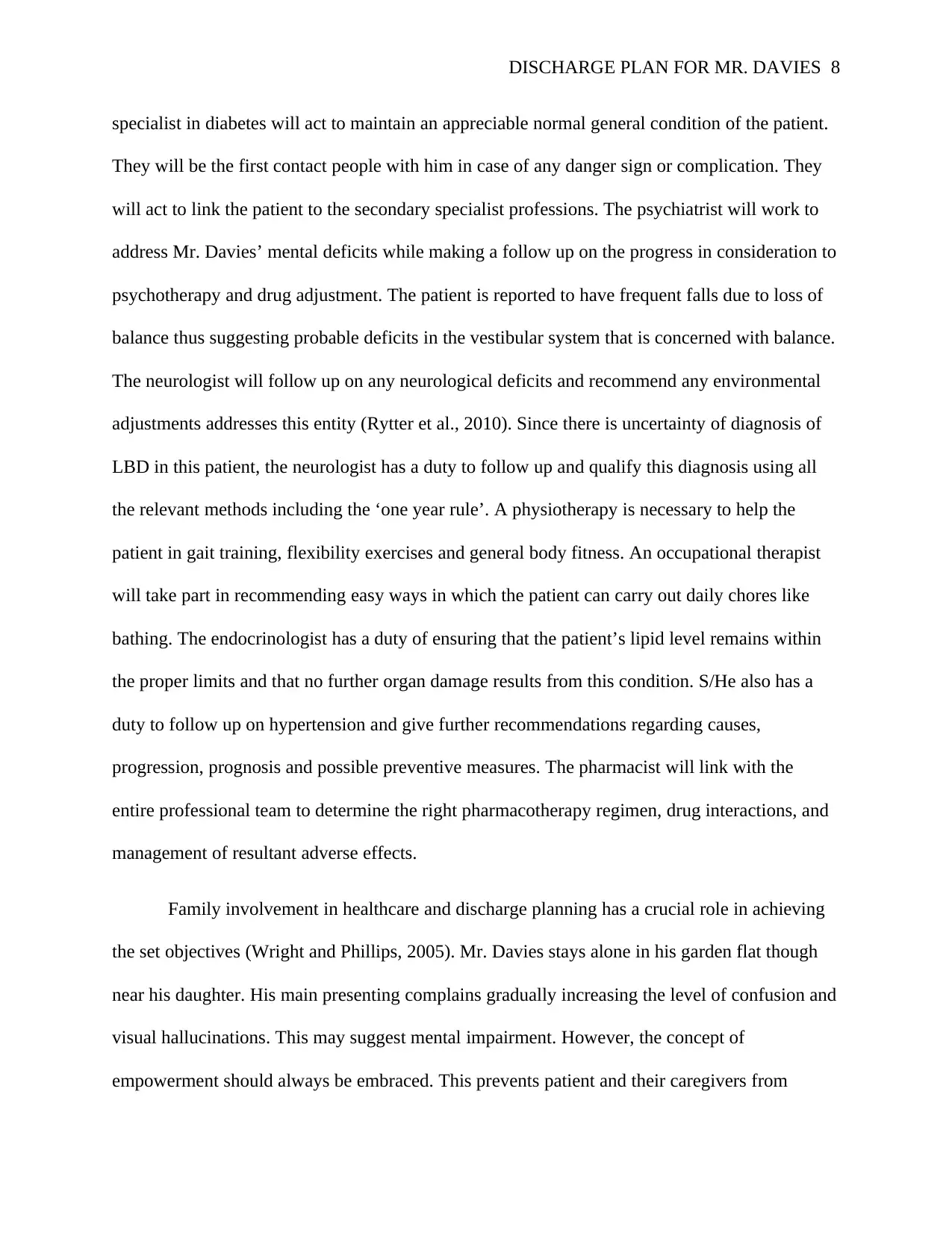
DISCHARGE PLAN FOR MR. DAVIES 8
specialist in diabetes will act to maintain an appreciable normal general condition of the patient.
They will be the first contact people with him in case of any danger sign or complication. They
will act to link the patient to the secondary specialist professions. The psychiatrist will work to
address Mr. Davies’ mental deficits while making a follow up on the progress in consideration to
psychotherapy and drug adjustment. The patient is reported to have frequent falls due to loss of
balance thus suggesting probable deficits in the vestibular system that is concerned with balance.
The neurologist will follow up on any neurological deficits and recommend any environmental
adjustments addresses this entity (Rytter et al., 2010). Since there is uncertainty of diagnosis of
LBD in this patient, the neurologist has a duty to follow up and qualify this diagnosis using all
the relevant methods including the ‘one year rule’. A physiotherapy is necessary to help the
patient in gait training, flexibility exercises and general body fitness. An occupational therapist
will take part in recommending easy ways in which the patient can carry out daily chores like
bathing. The endocrinologist has a duty of ensuring that the patient’s lipid level remains within
the proper limits and that no further organ damage results from this condition. S/He also has a
duty to follow up on hypertension and give further recommendations regarding causes,
progression, prognosis and possible preventive measures. The pharmacist will link with the
entire professional team to determine the right pharmacotherapy regimen, drug interactions, and
management of resultant adverse effects.
Family involvement in healthcare and discharge planning has a crucial role in achieving
the set objectives (Wright and Phillips, 2005). Mr. Davies stays alone in his garden flat though
near his daughter. His main presenting complains gradually increasing the level of confusion and
visual hallucinations. This may suggest mental impairment. However, the concept of
empowerment should always be embraced. This prevents patient and their caregivers from
specialist in diabetes will act to maintain an appreciable normal general condition of the patient.
They will be the first contact people with him in case of any danger sign or complication. They
will act to link the patient to the secondary specialist professions. The psychiatrist will work to
address Mr. Davies’ mental deficits while making a follow up on the progress in consideration to
psychotherapy and drug adjustment. The patient is reported to have frequent falls due to loss of
balance thus suggesting probable deficits in the vestibular system that is concerned with balance.
The neurologist will follow up on any neurological deficits and recommend any environmental
adjustments addresses this entity (Rytter et al., 2010). Since there is uncertainty of diagnosis of
LBD in this patient, the neurologist has a duty to follow up and qualify this diagnosis using all
the relevant methods including the ‘one year rule’. A physiotherapy is necessary to help the
patient in gait training, flexibility exercises and general body fitness. An occupational therapist
will take part in recommending easy ways in which the patient can carry out daily chores like
bathing. The endocrinologist has a duty of ensuring that the patient’s lipid level remains within
the proper limits and that no further organ damage results from this condition. S/He also has a
duty to follow up on hypertension and give further recommendations regarding causes,
progression, prognosis and possible preventive measures. The pharmacist will link with the
entire professional team to determine the right pharmacotherapy regimen, drug interactions, and
management of resultant adverse effects.
Family involvement in healthcare and discharge planning has a crucial role in achieving
the set objectives (Wright and Phillips, 2005). Mr. Davies stays alone in his garden flat though
near his daughter. His main presenting complains gradually increasing the level of confusion and
visual hallucinations. This may suggest mental impairment. However, the concept of
empowerment should always be embraced. This prevents patient and their caregivers from
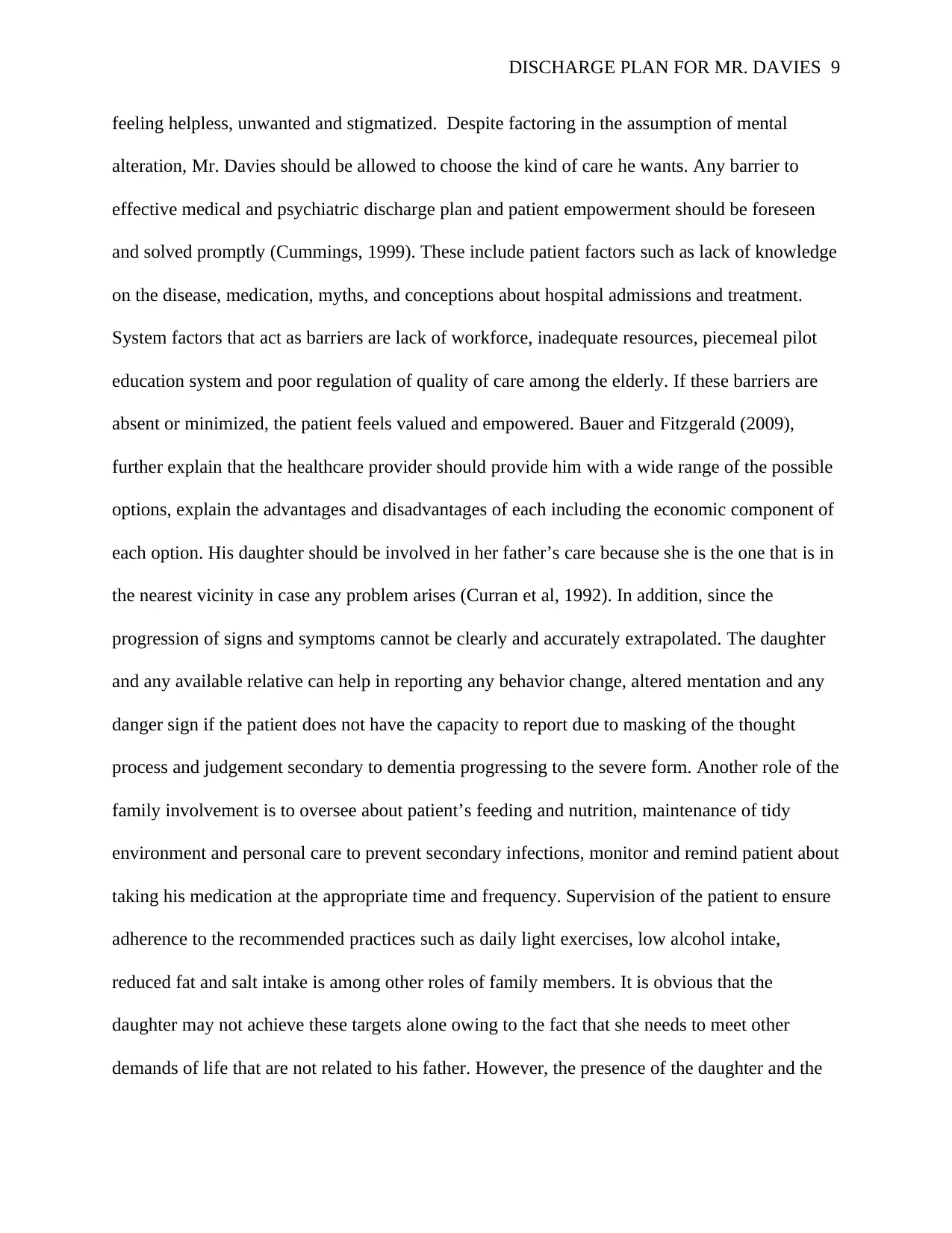
DISCHARGE PLAN FOR MR. DAVIES 9
feeling helpless, unwanted and stigmatized. Despite factoring in the assumption of mental
alteration, Mr. Davies should be allowed to choose the kind of care he wants. Any barrier to
effective medical and psychiatric discharge plan and patient empowerment should be foreseen
and solved promptly (Cummings, 1999). These include patient factors such as lack of knowledge
on the disease, medication, myths, and conceptions about hospital admissions and treatment.
System factors that act as barriers are lack of workforce, inadequate resources, piecemeal pilot
education system and poor regulation of quality of care among the elderly. If these barriers are
absent or minimized, the patient feels valued and empowered. Bauer and Fitzgerald (2009),
further explain that the healthcare provider should provide him with a wide range of the possible
options, explain the advantages and disadvantages of each including the economic component of
each option. His daughter should be involved in her father’s care because she is the one that is in
the nearest vicinity in case any problem arises (Curran et al, 1992). In addition, since the
progression of signs and symptoms cannot be clearly and accurately extrapolated. The daughter
and any available relative can help in reporting any behavior change, altered mentation and any
danger sign if the patient does not have the capacity to report due to masking of the thought
process and judgement secondary to dementia progressing to the severe form. Another role of the
family involvement is to oversee about patient’s feeding and nutrition, maintenance of tidy
environment and personal care to prevent secondary infections, monitor and remind patient about
taking his medication at the appropriate time and frequency. Supervision of the patient to ensure
adherence to the recommended practices such as daily light exercises, low alcohol intake,
reduced fat and salt intake is among other roles of family members. It is obvious that the
daughter may not achieve these targets alone owing to the fact that she needs to meet other
demands of life that are not related to his father. However, the presence of the daughter and the
feeling helpless, unwanted and stigmatized. Despite factoring in the assumption of mental
alteration, Mr. Davies should be allowed to choose the kind of care he wants. Any barrier to
effective medical and psychiatric discharge plan and patient empowerment should be foreseen
and solved promptly (Cummings, 1999). These include patient factors such as lack of knowledge
on the disease, medication, myths, and conceptions about hospital admissions and treatment.
System factors that act as barriers are lack of workforce, inadequate resources, piecemeal pilot
education system and poor regulation of quality of care among the elderly. If these barriers are
absent or minimized, the patient feels valued and empowered. Bauer and Fitzgerald (2009),
further explain that the healthcare provider should provide him with a wide range of the possible
options, explain the advantages and disadvantages of each including the economic component of
each option. His daughter should be involved in her father’s care because she is the one that is in
the nearest vicinity in case any problem arises (Curran et al, 1992). In addition, since the
progression of signs and symptoms cannot be clearly and accurately extrapolated. The daughter
and any available relative can help in reporting any behavior change, altered mentation and any
danger sign if the patient does not have the capacity to report due to masking of the thought
process and judgement secondary to dementia progressing to the severe form. Another role of the
family involvement is to oversee about patient’s feeding and nutrition, maintenance of tidy
environment and personal care to prevent secondary infections, monitor and remind patient about
taking his medication at the appropriate time and frequency. Supervision of the patient to ensure
adherence to the recommended practices such as daily light exercises, low alcohol intake,
reduced fat and salt intake is among other roles of family members. It is obvious that the
daughter may not achieve these targets alone owing to the fact that she needs to meet other
demands of life that are not related to his father. However, the presence of the daughter and the
⊘ This is a preview!⊘
Do you want full access?
Subscribe today to unlock all pages.

Trusted by 1+ million students worldwide
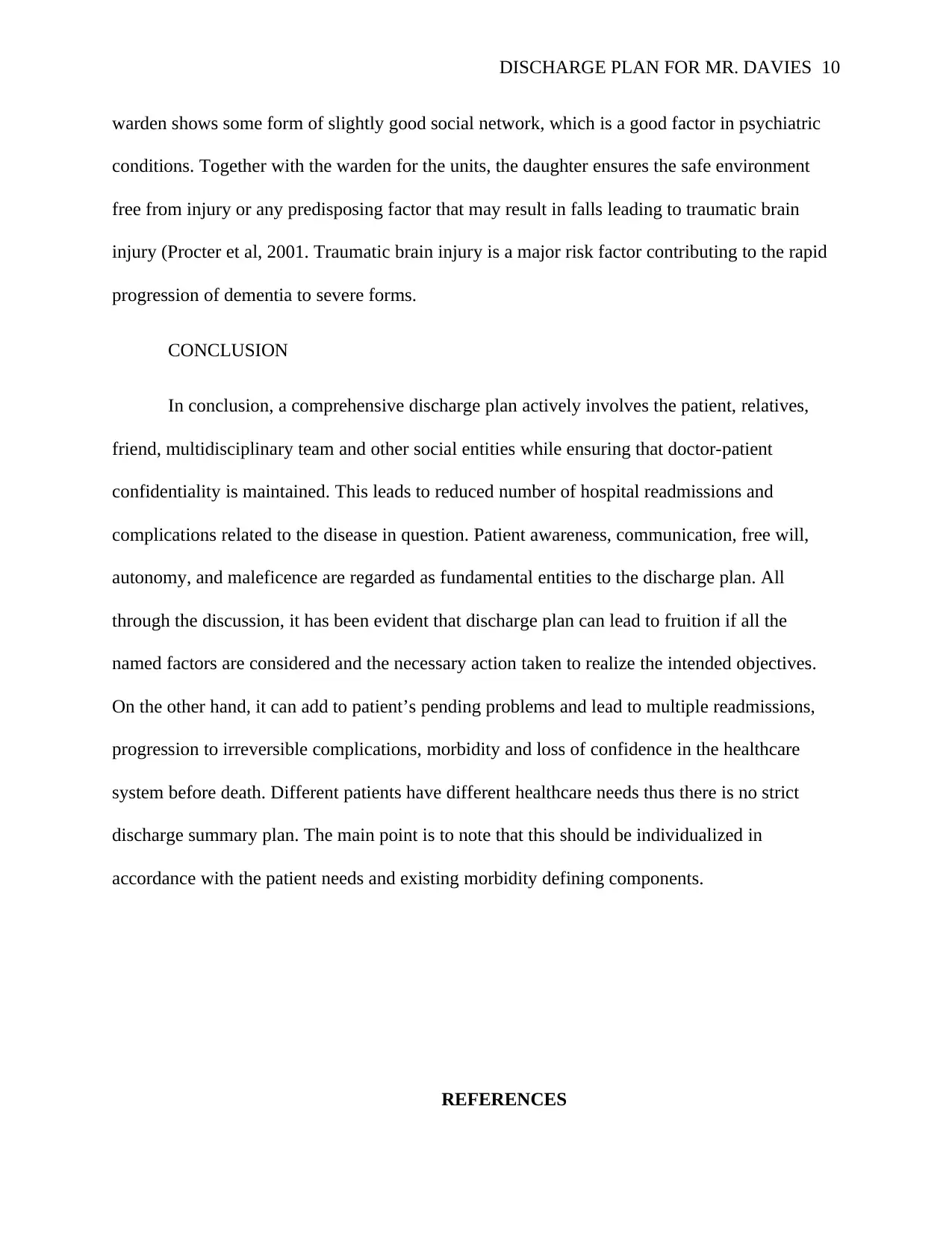
DISCHARGE PLAN FOR MR. DAVIES 10
warden shows some form of slightly good social network, which is a good factor in psychiatric
conditions. Together with the warden for the units, the daughter ensures the safe environment
free from injury or any predisposing factor that may result in falls leading to traumatic brain
injury (Procter et al, 2001. Traumatic brain injury is a major risk factor contributing to the rapid
progression of dementia to severe forms.
CONCLUSION
In conclusion, a comprehensive discharge plan actively involves the patient, relatives,
friend, multidisciplinary team and other social entities while ensuring that doctor-patient
confidentiality is maintained. This leads to reduced number of hospital readmissions and
complications related to the disease in question. Patient awareness, communication, free will,
autonomy, and maleficence are regarded as fundamental entities to the discharge plan. All
through the discussion, it has been evident that discharge plan can lead to fruition if all the
named factors are considered and the necessary action taken to realize the intended objectives.
On the other hand, it can add to patient’s pending problems and lead to multiple readmissions,
progression to irreversible complications, morbidity and loss of confidence in the healthcare
system before death. Different patients have different healthcare needs thus there is no strict
discharge summary plan. The main point is to note that this should be individualized in
accordance with the patient needs and existing morbidity defining components.
REFERENCES
warden shows some form of slightly good social network, which is a good factor in psychiatric
conditions. Together with the warden for the units, the daughter ensures the safe environment
free from injury or any predisposing factor that may result in falls leading to traumatic brain
injury (Procter et al, 2001. Traumatic brain injury is a major risk factor contributing to the rapid
progression of dementia to severe forms.
CONCLUSION
In conclusion, a comprehensive discharge plan actively involves the patient, relatives,
friend, multidisciplinary team and other social entities while ensuring that doctor-patient
confidentiality is maintained. This leads to reduced number of hospital readmissions and
complications related to the disease in question. Patient awareness, communication, free will,
autonomy, and maleficence are regarded as fundamental entities to the discharge plan. All
through the discussion, it has been evident that discharge plan can lead to fruition if all the
named factors are considered and the necessary action taken to realize the intended objectives.
On the other hand, it can add to patient’s pending problems and lead to multiple readmissions,
progression to irreversible complications, morbidity and loss of confidence in the healthcare
system before death. Different patients have different healthcare needs thus there is no strict
discharge summary plan. The main point is to note that this should be individualized in
accordance with the patient needs and existing morbidity defining components.
REFERENCES
Paraphrase This Document
Need a fresh take? Get an instant paraphrase of this document with our AI Paraphraser
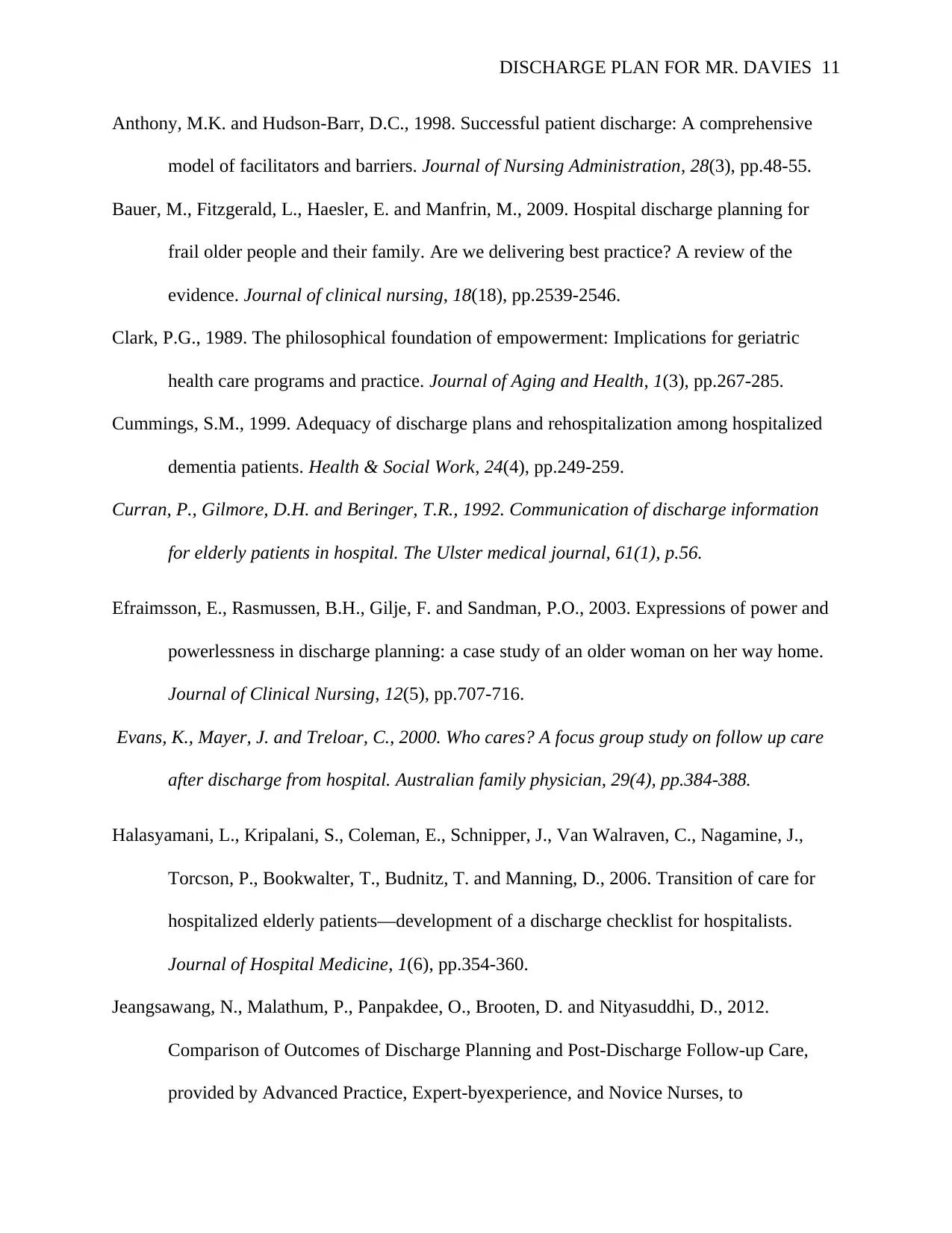
DISCHARGE PLAN FOR MR. DAVIES 11
Anthony, M.K. and Hudson-Barr, D.C., 1998. Successful patient discharge: A comprehensive
model of facilitators and barriers. Journal of Nursing Administration, 28(3), pp.48-55.
Bauer, M., Fitzgerald, L., Haesler, E. and Manfrin, M., 2009. Hospital discharge planning for
frail older people and their family. Are we delivering best practice? A review of the
evidence. Journal of clinical nursing, 18(18), pp.2539-2546.
Clark, P.G., 1989. The philosophical foundation of empowerment: Implications for geriatric
health care programs and practice. Journal of Aging and Health, 1(3), pp.267-285.
Cummings, S.M., 1999. Adequacy of discharge plans and rehospitalization among hospitalized
dementia patients. Health & Social Work, 24(4), pp.249-259.
Curran, P., Gilmore, D.H. and Beringer, T.R., 1992. Communication of discharge information
for elderly patients in hospital. The Ulster medical journal, 61(1), p.56.
Efraimsson, E., Rasmussen, B.H., Gilje, F. and Sandman, P.O., 2003. Expressions of power and
powerlessness in discharge planning: a case study of an older woman on her way home.
Journal of Clinical Nursing, 12(5), pp.707-716.
Evans, K., Mayer, J. and Treloar, C., 2000. Who cares? A focus group study on follow up care
after discharge from hospital. Australian family physician, 29(4), pp.384-388.
Halasyamani, L., Kripalani, S., Coleman, E., Schnipper, J., Van Walraven, C., Nagamine, J.,
Torcson, P., Bookwalter, T., Budnitz, T. and Manning, D., 2006. Transition of care for
hospitalized elderly patients—development of a discharge checklist for hospitalists.
Journal of Hospital Medicine, 1(6), pp.354-360.
Jeangsawang, N., Malathum, P., Panpakdee, O., Brooten, D. and Nityasuddhi, D., 2012.
Comparison of Outcomes of Discharge Planning and Post-Discharge Follow-up Care,
provided by Advanced Practice, Expert-byexperience, and Novice Nurses, to
Anthony, M.K. and Hudson-Barr, D.C., 1998. Successful patient discharge: A comprehensive
model of facilitators and barriers. Journal of Nursing Administration, 28(3), pp.48-55.
Bauer, M., Fitzgerald, L., Haesler, E. and Manfrin, M., 2009. Hospital discharge planning for
frail older people and their family. Are we delivering best practice? A review of the
evidence. Journal of clinical nursing, 18(18), pp.2539-2546.
Clark, P.G., 1989. The philosophical foundation of empowerment: Implications for geriatric
health care programs and practice. Journal of Aging and Health, 1(3), pp.267-285.
Cummings, S.M., 1999. Adequacy of discharge plans and rehospitalization among hospitalized
dementia patients. Health & Social Work, 24(4), pp.249-259.
Curran, P., Gilmore, D.H. and Beringer, T.R., 1992. Communication of discharge information
for elderly patients in hospital. The Ulster medical journal, 61(1), p.56.
Efraimsson, E., Rasmussen, B.H., Gilje, F. and Sandman, P.O., 2003. Expressions of power and
powerlessness in discharge planning: a case study of an older woman on her way home.
Journal of Clinical Nursing, 12(5), pp.707-716.
Evans, K., Mayer, J. and Treloar, C., 2000. Who cares? A focus group study on follow up care
after discharge from hospital. Australian family physician, 29(4), pp.384-388.
Halasyamani, L., Kripalani, S., Coleman, E., Schnipper, J., Van Walraven, C., Nagamine, J.,
Torcson, P., Bookwalter, T., Budnitz, T. and Manning, D., 2006. Transition of care for
hospitalized elderly patients—development of a discharge checklist for hospitalists.
Journal of Hospital Medicine, 1(6), pp.354-360.
Jeangsawang, N., Malathum, P., Panpakdee, O., Brooten, D. and Nityasuddhi, D., 2012.
Comparison of Outcomes of Discharge Planning and Post-Discharge Follow-up Care,
provided by Advanced Practice, Expert-byexperience, and Novice Nurses, to
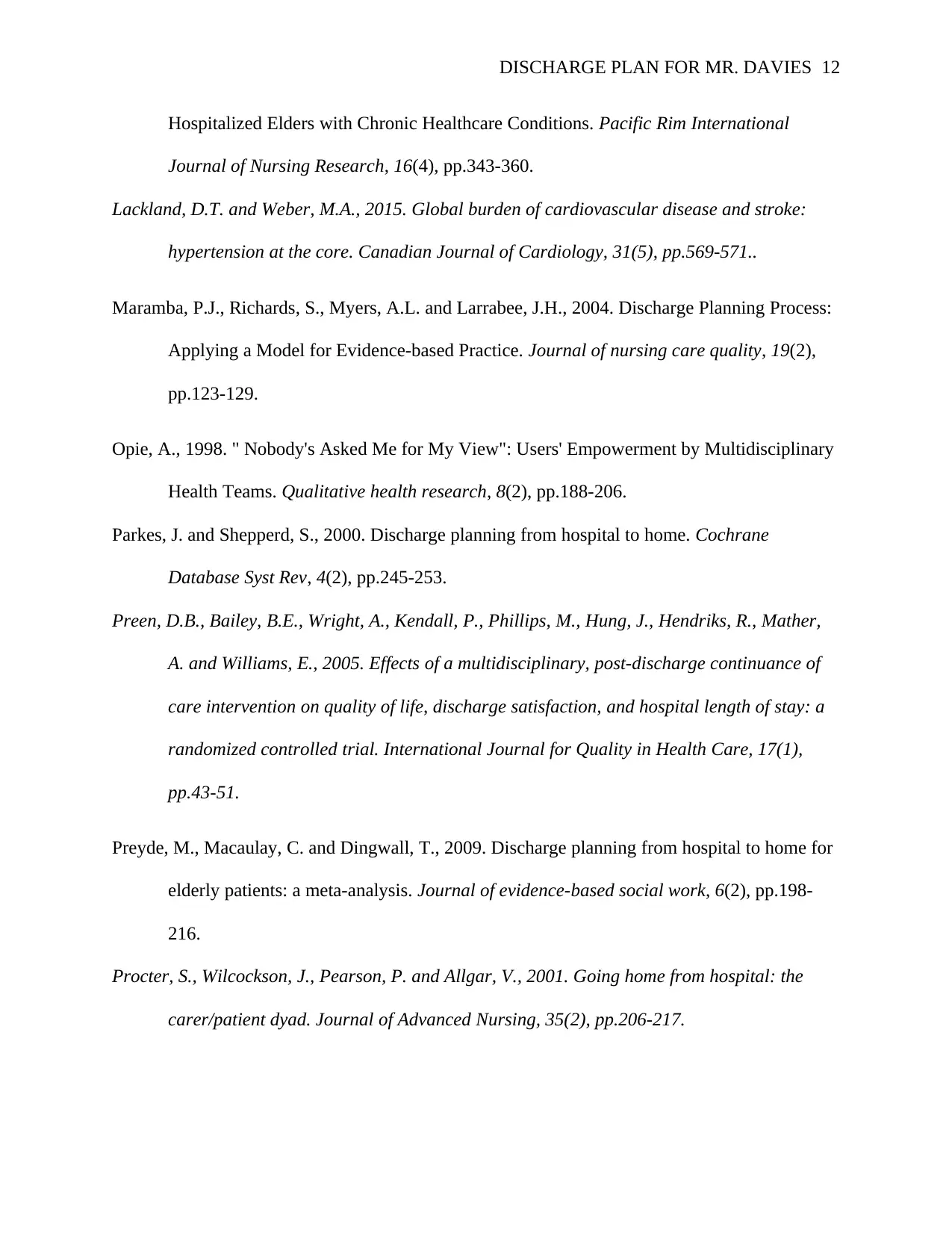
DISCHARGE PLAN FOR MR. DAVIES 12
Hospitalized Elders with Chronic Healthcare Conditions. Pacific Rim International
Journal of Nursing Research, 16(4), pp.343-360.
Lackland, D.T. and Weber, M.A., 2015. Global burden of cardiovascular disease and stroke:
hypertension at the core. Canadian Journal of Cardiology, 31(5), pp.569-571..
Maramba, P.J., Richards, S., Myers, A.L. and Larrabee, J.H., 2004. Discharge Planning Process:
Applying a Model for Evidence‐based Practice. Journal of nursing care quality, 19(2),
pp.123-129.
Opie, A., 1998. " Nobody's Asked Me for My View": Users' Empowerment by Multidisciplinary
Health Teams. Qualitative health research, 8(2), pp.188-206.
Parkes, J. and Shepperd, S., 2000. Discharge planning from hospital to home. Cochrane
Database Syst Rev, 4(2), pp.245-253.
Preen, D.B., Bailey, B.E., Wright, A., Kendall, P., Phillips, M., Hung, J., Hendriks, R., Mather,
A. and Williams, E., 2005. Effects of a multidisciplinary, post-discharge continuance of
care intervention on quality of life, discharge satisfaction, and hospital length of stay: a
randomized controlled trial. International Journal for Quality in Health Care, 17(1),
pp.43-51.
Preyde, M., Macaulay, C. and Dingwall, T., 2009. Discharge planning from hospital to home for
elderly patients: a meta-analysis. Journal of evidence-based social work, 6(2), pp.198-
216.
Procter, S., Wilcockson, J., Pearson, P. and Allgar, V., 2001. Going home from hospital: the
carer/patient dyad. Journal of Advanced Nursing, 35(2), pp.206-217.
Hospitalized Elders with Chronic Healthcare Conditions. Pacific Rim International
Journal of Nursing Research, 16(4), pp.343-360.
Lackland, D.T. and Weber, M.A., 2015. Global burden of cardiovascular disease and stroke:
hypertension at the core. Canadian Journal of Cardiology, 31(5), pp.569-571..
Maramba, P.J., Richards, S., Myers, A.L. and Larrabee, J.H., 2004. Discharge Planning Process:
Applying a Model for Evidence‐based Practice. Journal of nursing care quality, 19(2),
pp.123-129.
Opie, A., 1998. " Nobody's Asked Me for My View": Users' Empowerment by Multidisciplinary
Health Teams. Qualitative health research, 8(2), pp.188-206.
Parkes, J. and Shepperd, S., 2000. Discharge planning from hospital to home. Cochrane
Database Syst Rev, 4(2), pp.245-253.
Preen, D.B., Bailey, B.E., Wright, A., Kendall, P., Phillips, M., Hung, J., Hendriks, R., Mather,
A. and Williams, E., 2005. Effects of a multidisciplinary, post-discharge continuance of
care intervention on quality of life, discharge satisfaction, and hospital length of stay: a
randomized controlled trial. International Journal for Quality in Health Care, 17(1),
pp.43-51.
Preyde, M., Macaulay, C. and Dingwall, T., 2009. Discharge planning from hospital to home for
elderly patients: a meta-analysis. Journal of evidence-based social work, 6(2), pp.198-
216.
Procter, S., Wilcockson, J., Pearson, P. and Allgar, V., 2001. Going home from hospital: the
carer/patient dyad. Journal of Advanced Nursing, 35(2), pp.206-217.
⊘ This is a preview!⊘
Do you want full access?
Subscribe today to unlock all pages.

Trusted by 1+ million students worldwide
1 out of 19
Related Documents
Your All-in-One AI-Powered Toolkit for Academic Success.
+13062052269
info@desklib.com
Available 24*7 on WhatsApp / Email
![[object Object]](/_next/static/media/star-bottom.7253800d.svg)
Unlock your academic potential
Copyright © 2020–2025 A2Z Services. All Rights Reserved. Developed and managed by ZUCOL.




